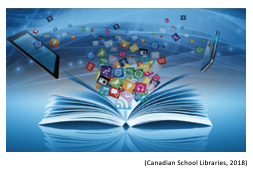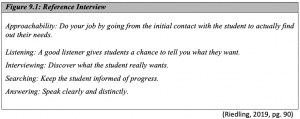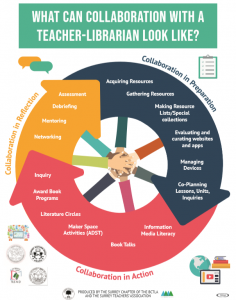Managing and Evaluating Reference Services
“In today’s rapidly changing society, students must have the  opportunity to develop the ability to retrieve, assess, and apply information. As we equip students with these skills, we will help ensure that learning does not end with the completion of formal education, but continues throughout life.” (Information Literacy Committee & Davies, n.d)
opportunity to develop the ability to retrieve, assess, and apply information. As we equip students with these skills, we will help ensure that learning does not end with the completion of formal education, but continues throughout life.” (Information Literacy Committee & Davies, n.d)
The theme of managing and evaluating reference services explored topics: reference interviews, managing a reference collection and evaluating reference services. Within these areas, however, the theme explored the over-arching question – what is the role of the teacher-librarian? Our class discussions focused on defining the role in 2020 and how the role of the teacher-librarian has evolved.
I have always rationalized the most essential role for the teacher-librarian is to develop, build and maintain a collection for the school community. This is a multi-step process that involves collaboration, fostering relationships with staff and students as well as being knowledgeable with curricular needs. A teacher-librarian needs to have an understanding of course topics, upcoming projects and students’ reading preferences. Riedling says that “one of the primary functions of a school librarian is to assist students in the use of the library and its collection.” In order to ascertain what a student wants, a teacher-librarian must conduct a reference interview. (Riedling, 2019, pg. 89)

Riedling further explains the reference interview in detail from exploring approachability and question types to creating a quiet, comfortable setting. Riedling’s discussion with the reference interview centrally focuses on the student/teacher-librarian reference interview and lacks highlighting the inclusion of the classroom teacher to the process, thereby minimizes the importance of cooperative planning. (Mueller, Lesson 5) Integrating cooperative planning within the role of the teacher librarian is a key component to supporting reference skills though Cooperative Program Planning and Teaching.
Russell’s article, “Teachers and Librarians: Collaborative Relationships” defines collaboration as being “based on shared goals, a shared vision, and a climate of trust and respect (Muronago & Harada, 1999). Each partner fulfills a carefully defined role; comprehensive planning is required; leadership, resources, risk, and control are shared; and the working relationship extends over a relatively long period of time.” (Russell, 2000) Shared collaboration between teachers and teacher-librarians is pivotal to running a successful learning commons.
The Learning Commons
Many of the discussions in this theme have centered on evaluating – what is the role of the teacher librarian? The answers that rise often relate to approachability, flexibility, and collaborators. School libraries have been changing over the past decade and libraries go beyond being places that exclusively house resources. On my school’s library homepage, our philosophy is shared with the community and states: “our library is a learning commons where physical and virtual spaces overlap and students and staff work independently and collaboratively.” (“Welcome to the Home Page of Rockridge Library Learning Commons”, n.d.) The below video from Richmond School District, elaborates on the evolution of the library to learning commons. The learning commons philosophy contributes to shaping the role of the teacher-librarian, most notably in how it relates to cooperative planning.
(Richmond SD38, 2019)
Cooperative Planning:
At my school the library team aims to engage in cooperative planning with teachers from the start of the year. This begins with quick refreshers on databases and new material in staff meetings and email blasts. We encourage classes/teacher collaboration and invite teachers to discuss upcoming topics they plan to explore, and we talk about ways we can help support information skills. We also find hosting early in the year a staff gathering with hot chocolate and treats as well as a display of pre-selected fiction and teacher resources brings the community together.
 Another way to jostle collaboration has been to maintain records from past years. What did Science 11 work on last November or what topics did English 12 begin in January? One example of this in my current teacher-librarian assignment, we anticipate months in advance that Social Studies 10 is going to be studying The October Crisis and FLQ in the spring, as they have done so in the past. Before Christmas, we checked in with all of the Socials 10 teachers as well as Learning Support to see if our current collection meets the needs of our students and anticipated research assignments. It was reconfirmed, after our initial assessment, that our resources were academically advanced and would not meet the needs for all learner profiles. We began researching for easier reading texts and ended up allocating a healthy chunk of the budget to developing this section in the library, knowing that all learner profiles would benefit from the additions. For a teacher-librarian to develop and build a successful collection, fostering relationships to ascertain community needs is essential. The best way to determine those needs are through cooperative planning and reference interviews. Essentially through cooperative planning with subject experts, teacher-librarians can efficiently conduct reference interviews with students, by being prepared with reference material selections and provide instruction on information skills. (Mueller, lesson 5)
Another way to jostle collaboration has been to maintain records from past years. What did Science 11 work on last November or what topics did English 12 begin in January? One example of this in my current teacher-librarian assignment, we anticipate months in advance that Social Studies 10 is going to be studying The October Crisis and FLQ in the spring, as they have done so in the past. Before Christmas, we checked in with all of the Socials 10 teachers as well as Learning Support to see if our current collection meets the needs of our students and anticipated research assignments. It was reconfirmed, after our initial assessment, that our resources were academically advanced and would not meet the needs for all learner profiles. We began researching for easier reading texts and ended up allocating a healthy chunk of the budget to developing this section in the library, knowing that all learner profiles would benefit from the additions. For a teacher-librarian to develop and build a successful collection, fostering relationships to ascertain community needs is essential. The best way to determine those needs are through cooperative planning and reference interviews. Essentially through cooperative planning with subject experts, teacher-librarians can efficiently conduct reference interviews with students, by being prepared with reference material selections and provide instruction on information skills. (Mueller, lesson 5)
(“Collaboration“, n.d.)
How Cooperative Planning Connects to Evaluation of References?
“Teacher-librarians work collaboratively with other teachers and school administrators to develop information literate students. Teachers and teacher-librarians work together to develop an instructional program that ensures that information literacy outcomes are integrated into student learning experiences in a developmental and sequential manner. These experiences allow students to learn and practice the necessary information skills across the curriculum. Teacher-librarians develop school information literacy plans that pinpoint the levels at which specific skills will be introduced and identify subject areas where they are most appropriately incorporated” (Asselin, 2003, pg. 57)
In the example mentioned earlier with Socials Studies 10 topics of the October Crisis and FLQ, an evaluation of references was undertaken and prompted by:
- Self-evaluation
-
- Did our references adequately support students/teachers on this topic last year? How can it be improved?
-
- “A statistical evaluation of the use of reference materials (circulation, reference interviews, student use etc.);” (Mueller, Lesson 7)
-
- Much of the reference materials are not permitted to be signed out, however, we are now maintaining scans on Destiny when these are accessed in reference interviews, so that the evaluation of circulation can be measured. In the topic of FLQ and October Crisis, no reference texts appeared to be used.
-
- “An evaluation of the “satisfaction” levels of students and teachers using the reference collection;” (Mueller, Lesson 7)
-
- We engaged in discussions with classroom teachers to understand research goals and to discuss reference material selections we currently have. What might improve? This collaborative approach helped us understand areas to focus on improving within the collection.
-
It is not practical to do the above for every reference source or even topic, however, in this case, it felt like the best approach. Mueller discusses evaluating reference services more broadly-beyond a singular reference text or topic within reference, but rather to look at the collection holistically. Some other considerations for evaluating reference services would be:
-
- Comparisons to accepted “Standards” outlining best practice, for example Achieving Information Literacy: Standards for School Library Programs in Canada.
- An evaluation of the teacher-librarian’s role as the person delivering the reference services
- Peer (teacher-librarian to teacher-librarian) evaluation;
- Administrative evaluation of our library program in general; (Mueller, Lesson 7)
Further, when evaluating reference services, and “deciding where and how learning resources should be organized, located, and stored, those involved in these decisions must ensure that the resources are easily accessible by staff and students. The format, cost, and number of learning resources, as well as the personnel and facilities available, will be factors in these decisions.” (Evaluating, Selecting and Managing Learning Resources: A Guide, 2002, page 87) The guide further explores how the organization of support should be divided into three areas: intellectual access, physical access and digital access. Riedling touches on this briefly and reinforces the need for a planned, organized, weeded and accurate arrangement of a reference collection. She acknowledges, “at the elementary level, reference instruction continues to use print sources because of the difficulty young children experience in navigating the Internet. However, the use of print resources decreases as the level of education increases because older students can make effective use of the sophisticated search interfaces and the wide variety of reference resources available online.” (Riedling,2019, pg. 26)
Final Thoughts:
Maintaining a reference collection that meets the needs of the school community is one of the largest responsibilities for teacher-librarians. It goes beyond curating a collection and requires continual cooperative planning/collaboration with teachers, understanding the school community and curricular needs, frequent evaluation of reference services, budget maintenance and record keeping. Record keeping should include past library lessons, research requests and statistic information about the circulation of the collection as well as database use. Teacher-librarian roles evolve and adapt much like our spaces have and the flexibility to move and grow keeps the job exciting.
“Collection Development is a process of systematically building library collections to serve, study, teach, research and meet other needs of students and teachers.” (Riedling, 2019, pg.15)
References:
Asselin, M., Branch, J., & Odberg, D. (Eds.). (2003). Achieving information literacy: Standards for school library programs in Canada. Retrieved from http://accessola2.com/SLIC-Site/slic/ail110217.pdf
Canadian School Libraries (CSL) [Image]. (2018) “Leading Learning: Standards of Practice for School Library Learning Commons in Canada.” Retrieved from: http://llsop.canadianschoollibraries.ca
Collaboration. (n.d.). Retrieved February 23, 2020, from
https://www.surreyschools.ca/llc/instructionalpractice/collaboration/Pages/
default.aspx
Evaluating, selecting, and managing learning resources: A guide. (2002). Victoria, B.C.: British Columbia Ministry of Education.
Information Literacy Committee, & Davies, J. (n.d.). Resource-Based Learning. What is it? Retrieved February 20, 2020, from Information Literacy & Learning website: http://www.edu.pe.ca/BIL/bil.asp?ch1.s2.gdtx
Mueller, Aaron. (2020) Lesson 5: The Reference Interview: Cooperative Program Planning and Teaching for Personalized Inquiry.
Mueller, Aaron. (2020) Lesson 7: Evaluating Reference Services.
Richmond SD38 (Producer). (2019). The Evolution of the Library [Video file]. Retrieved from https://youtu.be/5sadWGKFs4k
Riedling, A. M., & Houston, C. (2019). Reference skills for the school librarian: Tools and tips (4th ed.). Santa Barbara, CA: Libraries Unlimited, an imprint of ABC CLIO.
Russell, S. (2000). Teachers and Librarians: Collaborative Relationships. Eric Digests, (ED444605). Retrieved from ERIC database.
Welcome to the Home Page of Rockridge Library Learning Commons. (n.d.). Retrieved February 20, 2020, from http://www.sd45slc.ca/about-rockridge-library.html

 Follow
Follow
Well done reflection post on theme 2. I really appreciated how you took the big ideas and concepts from our explorations and contexualized them within the good work you are doing back in your own library, supporting your own school community. Your team is well organized and communicates and plans very well. A good amount of references, resources, citations and support from our course texts and other tools, as well as strong practical examples of strategies and approaches to support better utilization of reference resources, services and planning. Great reflection!
Nicole, I appreciated hearing about your own concrete examples of collaboration as it relates to evaluation of references. Also, what an inspiring video from the Richmond School District! I had not come across it yet. Thank you for sharing it!